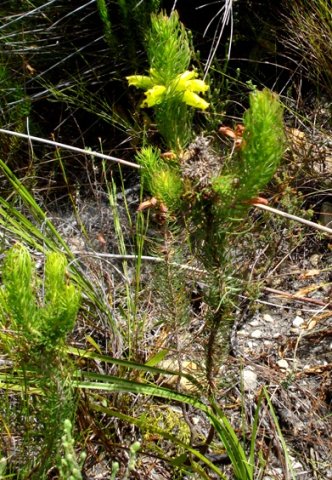Erica viscaria subsp. longifolia

Author: Ivan Lätti
Photographer: Judd Kirkel Welwitch
Erica viscaria, commonly known as sticky heath due to the stickiness upon the flower tubes, has six subspecies, viz. E. viscaria subsp. gallorum (short pink or bicolour pink and white flowers, near Elgin), subsp. longifolia (the one in picture, variably coloured flowers, commonly known as the longleaf heath, more widespread in the Western Cape than many of the others), subsp. macrosepala (big sepals, yellow, green or white flowers, near the Kleinrivier Mountains), subsp. pendula (pendulous white flowers, from Kleinmond to Botrivier), subsp. pustulata (pustules, blisters or pimples along leaf and sepal surfaces, yellow flowers, Kleinrivier Mountains, Hermanus) and subsp. viscaria (shorter corollas, 5 mm to 9 mm, Cape Peninsula and Cape flats). The specific name, viscaria, is derived from the Latin viscus meaning birdlime and -arius indicating possession or connection, referring to the flower stickiness.
E. viscaria is one of the species in the Hermes section of the Erica genus according to the Baker and Oliver classification of ericas, the plants being characterised by variously shaped flowers in axillary spikes and the anthers included in the corolla, i.e. not exserted beyond the mouth. E. viscaria subsp. longifolia shrubs are compact or sometimes grow tall, willowy and erect to 90 cm in height, their branches wand-like. Manning and Helme classify the species under Large Bottlebrush Heaths, plants that produce single flowers from upper stem leaf axils in whorls or racemes.
The distribution of E. viscaria along lower slopes and flats of the far south-western parts of the Western Cape ranges from Mamre and Paarl to around Bredasdorp; much variation occurring in the relatively small geographical distribution. Flowering seasons of these plants also vary. The photo was taken in the Fernkloof Nature Reserve late in October.
The species habitat is fynbos slopes and flats in sandstone derived soils. The habitat population of subsp. longifolia is deemed of least concern early in the twenty first century (Manning and Helme, 2024; Bean and Johns, 2005; Baker and Oliver, 1967; Andrew, 2012; iNaturalist; iSpot; http://redlist.sanbi.org).

